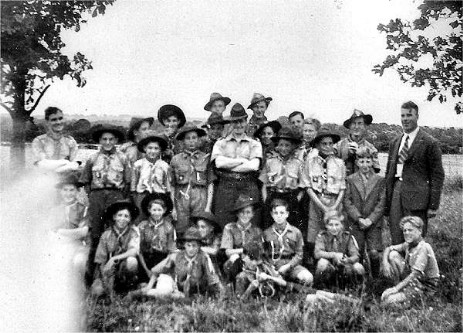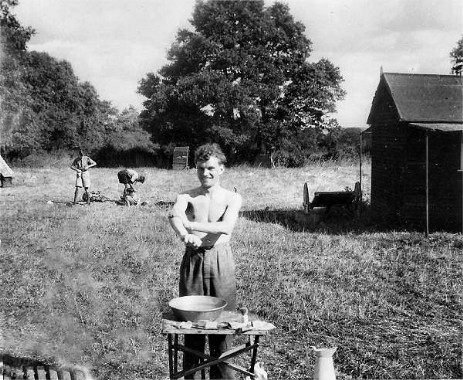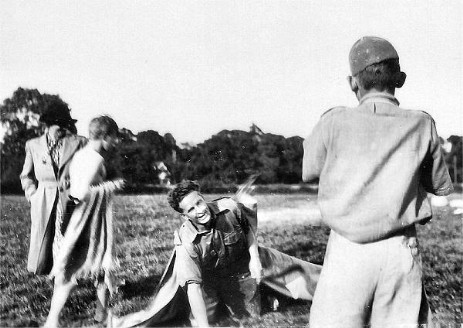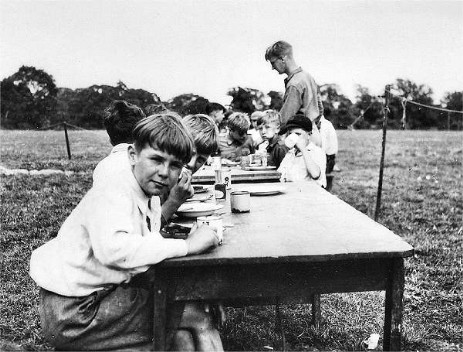introduction
Post-war Scouting in Brixton and Stockwell
by Stan Allen
My brother and I returned to London from war-years as evacuees in Lincolnshire in Summer 1945. Our parents realised that our short life as outdoor boys on a farm needed to be replicated in London’s smashed streets and war torn parks. So the news of a Scout troop being started at Christ Church, North Brixton, was manna indeed.
Brother Reg and I joined a stream of youngsters making its way down the left-hand side of the church into a cavern of a hall. We were split into four patrols of eight: with temporary names of Fleas, Flies, Frogs and Fishes - just for that night. And I was appointed leader of the patrol lined on the left of the parade.

Happy hikers with “Skipper” Reg Allen on right before he joined the uniformed ranks - at Smallfield in Surrey, 1948/9.
The following week we were allocated Seagulls (mine), Eagles (Eddy Baldwinson), Owls (Mick Cooper) and Wolves (brother Reg). The adult leaders Landridge, Johnson and Duffy then made Reg troop leader as he was a couple of years older than the rest of us.
Reg and I went home complaining about the amount of “stuff” we were not getting taught at Scouts and so Skipper Allen (our dad) came into being. Using contacts, he soon provided us with twenty rucksacks, 14ft brown ex-forces tents, bell tents, corset rubber for groundsheets, USA bivvies that buttoned together and various cooking pots - that we still use at summer camps. Each patrol also had its own flag on a 6ft ash stave.

Assistant Scout Master Mr Duffy at the CPAS camp near Smallfield in Surrey, 1948/9.
Using contacts, he soon provided us with twenty rucksacks, 14ft brown ex-forces tents, bell tents, corset rubber for groundsheets, USA bivvies that buttoned together and various cooking pots - that we still use at summer camps. Each patrol also had its own flag on a 6ft ash stave.
Bombsites that were often knee deep in bricks, masonry and glass acted as our playgrounds. We cleared one site at the end of Stockwell's Hackford Road to use as a speedway for push bikes with the track laid out with house bricks.
David Levy lived in a flat and came into hall one night to cause trouble and was, in many ways, typical of the children we attracted. He was a London school boxing champ and stayed for several years.
One Christmas time we went into Kent for a day’s hiking and took David with us. We stopped for lunch by the roadside and started to light a fire for a hot drink. David is still famous for asking “Who’s got the coal?”. We also cooked with our ex-Army mess tins at the rear of the church hall. My first effort at porridge saw the Scoutmaster grimace and exclaim “It is burnt”. I took the spoon and ate it all to prove that it was not! For fuel we used the wooden blocks that were being removed from either side of the tram tracks and soaked in oil.

Rev Bosley emerges from a pinned down sheet and covered in flour during an “adventure trail” - at Smallfield in Surrey, 1948/9.

Getting down to alfresco tea with bread and jam and tea in lip-burning enamel mugs - at Smallfield in Surrey, 1948/9
The next few years saw the 42nd win District boxing competitions, swimming galas, athletics at Tooting Bec track and first aid competitions. Plus some very happy summer camps at Bridge House in Twyford - right next to the River Lodden for swimming and fishing. Reg became the first Kings Scout from the 42nd.
We built a sandpit round the side of the church and used it for tracking games as described by Baden-Powell in his books. Reading marks in the sand would indicate that a one-legged man with a walking stick had met a man with his shoes on backwards and smoked a cigarette each in the left hand - or something like. One grand adventure was to climb over the church roof and not get caught.
I must have been tricky to handle for the Scoutmasters and Landridge once confided that he had thought of asking me to leave. Fifty years later I found that I had, in fact, left!
The vicar, the Rev Bosley, moved on and we “got” the Reverend Pizzie in his place. He quickly made it known that he favoured the Campaigners youth movement and said that he not only wanted the scouts to attend the conventional monthly church parade but also Sunday School every week.
One boy, Michael State, went home to Grove Way and told his father, Laurie, that we were on the verge of closing down. Laurie State spoke to the vicar at St Michael’s, Stockwell, and so we transferred lock-stock-and-barrel to Stockwell Park Crescent.
There we discovered a troop flag emblazoned with the words THE STOCKWELL TROOP, an early trek cart with “ladder” sides and accounts for the 8th Lambeth going back to 1909. We had come back home.
(Stan Allen - November 2013)